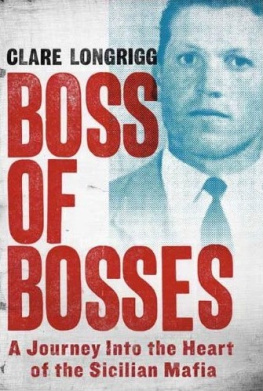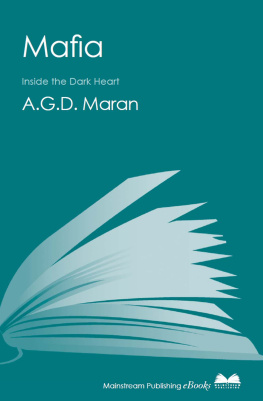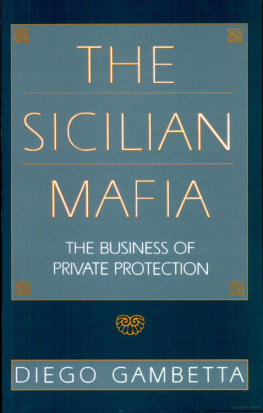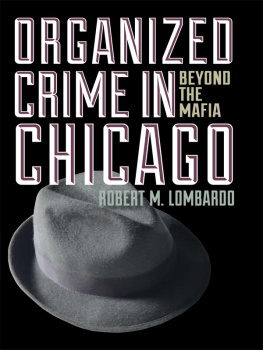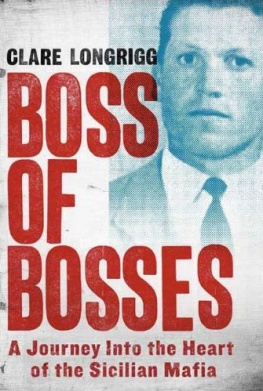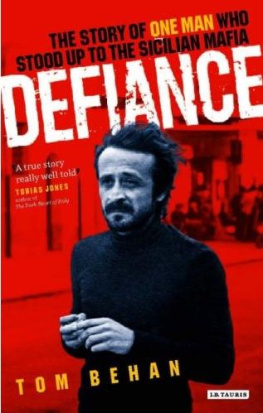Boss of Bosses
Also by Clare Longrigg
Mafia Women
No Questions Asked
Boss of Bosses
A Journey into the Heart
of the Sicilian Mafia
CLARE LONGRIGG
Thomas Dunne Books
St. Martins Press
New York

THOMAS DUNNE BOOKS .
An imprint of St. Martins Press.
BOSS OF BOSSES . Copyright 2008 by Clare Longrigg. All rights reserved. Printed in the United States of America. For information, address St. Martins Press, 175 Fifth Avenue, New York, N.Y. 10010.
www.thomasdunnebooks.com
www.stmartins.com
Library of Congress Cataloging-in-Publication Data
Longrigg, Clare.
Boss of bosses / Clare Longrigg. 1st U.S. ed.
p. cm.
Includes bibliographical references and index.
ISBN-13: 978-0-312-53394-6
ISBN-10: 0-312-53394-2 |
1. Provenzano, Bernardo, 1933 2. MafiosiItaly
Biography. 3. MafiaItalyHistory. I. Title.
HV6453.I83M3543455 2009
364.1092dc22
[B] |
2008039095
First published in Great Britain by John Murray (Publishers),
an Hachette Livre UK company
First U.S. Edition: April 2009
10 9 8 7 6 5 4 3 2 1
For Adrian
Contents
List of illustrations
Illustration Credits: Lannino & Naccari/Studio Camera Palermo, viale Lazio Alessandro Fucarini
Acknowledgements
I have to thank my great friend Rino Cascio, a brilliant journalist with whom I have been privileged to work, who has been a tireless, resourceful and knowledgeable researcher on this project and always great fun.
Id like to thank Linda Pantano for her help with research and, of course, the peerless staff of the Istituto Gramsci in Palermo. Thanks to Rino, Linda and Alberto for their wonderful hospitality.
Thanks to Piera Fallucca and Antonella Maggio for their ideas and Mafia tours.
Pippo Cipriani was incredibly generous with his time and knowledge. Salvo Palazzolo, author of two brilliant books on Provenzano, was a fount of ideas and information, and generous with help on documentation.
Thanks to Saverio Lodato for giving me permission to quote from his excellent books based on interviews with Tommaso Buscetta and Giovanni Brusca.
Id like to thank the experts lawyers, prosecutors and investigators who agreed to be interviewed for this book, especially Alfonso Sabella, Nino Di Matteo and Michele Prestipino, General Angiolo Pellegrini and Rosalba di Gregorio.
Thanks to my agent Derek Johns, to Linda Shaughnessy, to my editor Rowan Yapp, and particular thanks to Roland Philipps. Thanks also to Ian Katz at The Guardian, who commissioned the article that set the whole project in motion.
Id like to thank Emma Cook and Laura Longrigg for their comments on the manuscript, and Dani Golfieri for emergency translation. Thanks to Christine Langan and Christian Spurrier, Camilla Nicholls, Amanda Sutton, Natasha Fairweather and Rick Beeston, and Denise and Charlie Meredith for their friendship and support. Thanks to Nigel Skeels for help with my website.
Heartfelt thanks to Helen and Bruce Buchanan. Thanks to my mother and sister Francesca for their constant support.
Finally, thanks to my husband, Adrian Buchanan, and my children, Patrick and Alice, who had to put up with my year-long absence.
Boss of Bosses
Introduction
Theres someone inside.
The voice of Il Segugio (Bloodhound), one of the agents posted on the mountain, crackled over the radio. He had been watching the shepherds hut day and night for over a week, looking for a sign of life. This was the signal his commander had been waiting for.
We had been watching the sheep farm for days, said police chief Giuseppe Gualtieri, and the door to the hut was always closed. Some days the shepherd arrived at seven in the morning and opened the door, but he never went in. He stood in the doorway, and sometimes it looked as though he was talking to the wall... it looked wrong somehow. We wanted to go up close at night and see what was in there, but then we thought, careful: if there was someone hiding in the cottage, we didnt want to risk frightening him off and destroying all our hard work. We would wait.
One day we saw the shepherd standing in front of the cottage, fiddling with an aerial. We wondered, whats that for? Why would you need an aerial on an uninhabited house? It was a couple of days before the elections, so we were thinking, which fugitive takes a keen interest in politics?
Shortly after that, a package was delivered to the cottage that looked like it could be a television set. We said, Oh my God! One of them comes up with an aerial, the other one turns up with a television, theres got to be someone living inside, and it could be Bernardo Provenzano.
Early on the morning of 11 April 2006 the shepherd opened the door as usual, and just for a fleeting moment the observers up on the mountain saw an arm reach out from inside. It was all the proof they needed. The police unit got into position: the leader, Renato Cortese, moved up to a point 4 km away with eighteen men; the chiefs waited in the cover of the nearby forest.
Go! Bloodhounds voice came over the radio, loud and clear. Everyone knew what to do; theyd been rehearsing this moment in their sleep.
When Cortese burst into the little farm building, the old man tried to slam the door in his face, but he threw himself against it, smashing the glass with his fist. For a moment the old man looked like a trapped animal, then he composed himself to face his captor.
You dont know what you are doing, he said in a low voice. He spoke quietly, with a strong Sicilian accent. Cortese thought he might be trying to say theyd got the wrong man. He checked for the scar on the old mans neck: there it was. He had been told of another identifying sign: the Boss would be wearing three silver crosses on a chain. Sure enough, they were hidden under his shirt. There was no doubt, it was Provenzano. After forty-three years on the run the Boss of Bosses had finally been caught.
I looked into his eyes, and I knew it was him, Cortese said.
One of the agents, nicknamed the Director, had recorded the build-up to the arrest on a hand-held camera. Seeing the lens turned on him, Provenzano hid his face. When he finally lowered his hands, he was composed, fixing his visitors with a scornful expression, an inscrutable half-smile, offering his hand and his congratulations.
Outside the cottage the agents hugged each other and wept, whooped with euphoria and phoned their loved ones. In the midst of this scene of wild celebration Gualtieri followed Cortese into the hut. He wore a knowing smile, as though to say, You think youve won, but you havent. Capturing me doesnt change anything. Cosa Nostra isnt beaten.
The place they found Provenzano, in the mountains above Corleone, was known as the triangle of death: a couple of miles away were the ravines and forests where Provenzanos earliest victims had met their violent ends. He had come home.
The massive international media coverage and frenzied analysis that followed Provenzanos arrest was largely due to the fact that, until that moment, very little was known about the boss of Cosa Nostra. He was one of the most powerful criminal leaders in Europe, and hadnt been seen in public for over forty years. The mystique that had built up around him made his arrest an object of fascination world-wide yet even then there were no easy answers. People watching the news all over the world were shocked at the humble circumstances in which Provenzano was living: the tiny shepherds hut reeked of rotting vegetables and urine, his diet of bread and onions... how had the Boss of Bosses, at the age of seventy-three, been reduced to this?

